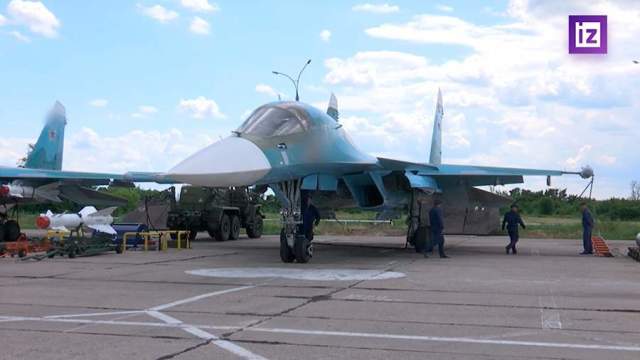The concept of "non-flying weather" for pilots of modern fighter-bombers practically does not exist. The Su-34 takes off to perform tasks at any time of the day and under any weather conditions. The footage of the military airfield on Monday, June 20, was presented by the military correspondent of Izvestia Kirill Olkov.
Before each combat mission, the procedure for checking meteorological conditions is mandatory. The first to go into battle is a weather scout — a special weather agent. The pre-flight preparation of the Su-34 resembles a well-oiled conveyor. Technicians have already filled their hands — the process of checking all systems has been reduced to a minimum.
The air–to-surface missile is designed to destroy bridges and railway crossings. Its range is 30 km. Air–to-air missiles have not been used here for a long time. The Su-34 has no worthy opponents left in the sky. The threat comes from Earth. But it is also not capable of causing much harm to the aircraft.
"There were cases when at low altitudes the plane was hit by fragments. But he returned safely. And soon he went to take off again. It took a few hours to recover," said Maxim, an engineer of the aviation group.
Special heat traps are used on the Su-34 to protect against a ground threat. Outwardly, their work looks like a small firework. These bright balls confuse the enemy's weapons. The cockpit of the fighter consists entirely of armor. It is based on a titanium alloy. Nothing can take such a thing. But the enemy has no protection from the Su-34 — it aims at a distance of several tens of kilometers and suddenly attacks.
In such a strenuous work, there is no way without support. Pilots always have it. The military say that they constantly receive warm words from relatives and even strangers.
On June 14, a military correspondent of Izvestia took a video of the work of Russian aviation in the city of Popasnaya. In the footage, fighters drop ammunition on the positions of the Armed Forces of Ukraine, the data on which were obtained in advance.
Russia continues the special operation to protect Donbass, which President Vladimir Putin announced on February 24. A few days earlier, the situation in the region significantly worsened due to shelling by the Ukrainian military. The authorities of the Donetsk and Lugansk People's Republics announced the evacuation of residents to the Russian Federation, and also appealed to Moscow for help. On February 21, Russian President Vladimir Putin signed a decree recognizing the independence of the DPR and the LPR.
For more relevant videos and details about the situation in Donbass, watch the Izvestia TV channel.

